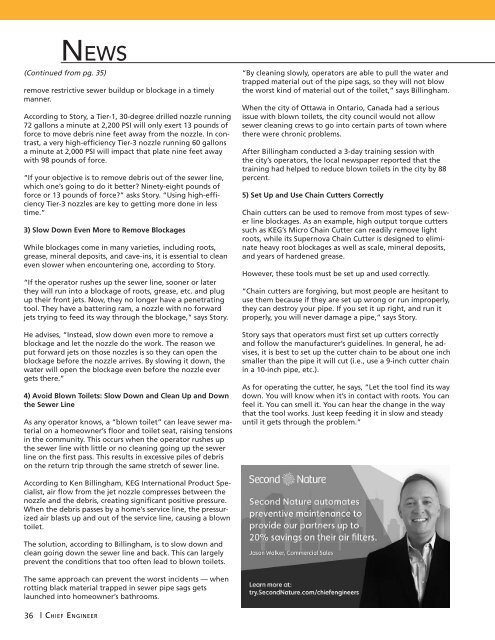CEAC-2022-03-March
You also want an ePaper? Increase the reach of your titles
YUMPU automatically turns print PDFs into web optimized ePapers that Google loves.
News<br />
(Continued from pg. 35)<br />
remove restrictive sewer buildup or blockage in a timely<br />
manner.<br />
According to Story, a Tier-1, 30-degree drilled nozzle running<br />
72 gallons a minute at 2,200 PSI will only exert 13 pounds of<br />
force to move debris nine feet away from the nozzle. In contrast,<br />
a very high-efficiency Tier-3 nozzle running 60 gallons<br />
a minute at 2,000 PSI will impact that plate nine feet away<br />
with 98 pounds of force.<br />
“If your objective is to remove debris out of the sewer line,<br />
which one’s going to do it better? Ninety-eight pounds of<br />
force or 13 pounds of force?” asks Story. “Using high-efficiency<br />
Tier-3 nozzles are key to getting more done in less<br />
time.”<br />
3) Slow Down Even More to Remove Blockages<br />
While blockages come in many varieties, including roots,<br />
grease, mineral deposits, and cave-ins, it is essential to clean<br />
even slower when encountering one, according to Story.<br />
“If the operator rushes up the sewer line, sooner or later<br />
they will run into a blockage of roots, grease, etc. and plug<br />
up their front jets. Now, they no longer have a penetrating<br />
tool. They have a battering ram, a nozzle with no forward<br />
jets trying to feed its way through the blockage,” says Story.<br />
He advises, “Instead, slow down even more to remove a<br />
blockage and let the nozzle do the work. The reason we<br />
put forward jets on those nozzles is so they can open the<br />
blockage before the nozzle arrives. By slowing it down, the<br />
water will open the blockage even before the nozzle ever<br />
gets there.”<br />
4) Avoid Blown Toilets: Slow Down and Clean Up and Down<br />
the Sewer Line<br />
As any operator knows, a “blown toilet” can leave sewer material<br />
on a homeowner’s floor and toilet seat, raising tensions<br />
in the community. This occurs when the operator rushes up<br />
the sewer line with little or no cleaning going up the sewer<br />
line on the first pass. This results in excessive piles of debris<br />
on the return trip through the same stretch of sewer line.<br />
“By cleaning slowly, operators are able to pull the water and<br />
trapped material out of the pipe sags, so they will not blow<br />
the worst kind of material out of the toilet,” says Billingham.<br />
When the city of Ottawa in Ontario, Canada had a serious<br />
issue with blown toilets, the city council would not allow<br />
sewer cleaning crews to go into certain parts of town where<br />
there were chronic problems.<br />
After Billingham conducted a 3-day training session with<br />
the city’s operators, the local newspaper reported that the<br />
training had helped to reduce blown toilets in the city by 88<br />
percent.<br />
5) Set Up and Use Chain Cutters Correctly<br />
Chain cutters can be used to remove from most types of sewer<br />
line blockages. As an example, high output torque cutters<br />
such as KEG’s Micro Chain Cutter can readily remove light<br />
roots, while its Supernova Chain Cutter is designed to eliminate<br />
heavy root blockages as well as scale, mineral deposits,<br />
and years of hardened grease.<br />
However, these tools must be set up and used correctly.<br />
“Chain cutters are forgiving, but most people are hesitant to<br />
use them because if they are set up wrong or run improperly,<br />
they can destroy your pipe. If you set it up right, and run it<br />
properly, you will never damage a pipe,” says Story.<br />
Story says that operators must first set up cutters correctly<br />
and follow the manufacturer’s guidelines. In general, he advises,<br />
it is best to set up the cutter chain to be about one inch<br />
smaller than the pipe it will cut (i.e., use a 9-inch cutter chain<br />
in a 10-inch pipe, etc.).<br />
As for operating the cutter, he says, “Let the tool find its way<br />
down. You will know when it’s in contact with roots. You can<br />
feel it. You can smell it. You can hear the change in the way<br />
that the tool works. Just keep feeding it in slow and steady<br />
until it gets through the problem.”<br />
According to Ken Billingham, KEG International Product Specialist,<br />
air flow from the jet nozzle compresses between the<br />
nozzle and the debris, creating significant positive pressure.<br />
When the debris passes by a home’s service line, the pressurized<br />
air blasts up and out of the service line, causing a blown<br />
toilet.<br />
The solution, according to Billingham, is to slow down and<br />
clean going down the sewer line and back. This can largely<br />
prevent the conditions that too often lead to blown toilets.<br />
The same approach can prevent the worst incidents — when<br />
rotting black material trapped in sewer pipe sags gets<br />
launched into homeowner’s bathrooms.<br />
36<br />
| Chief Engineer


















